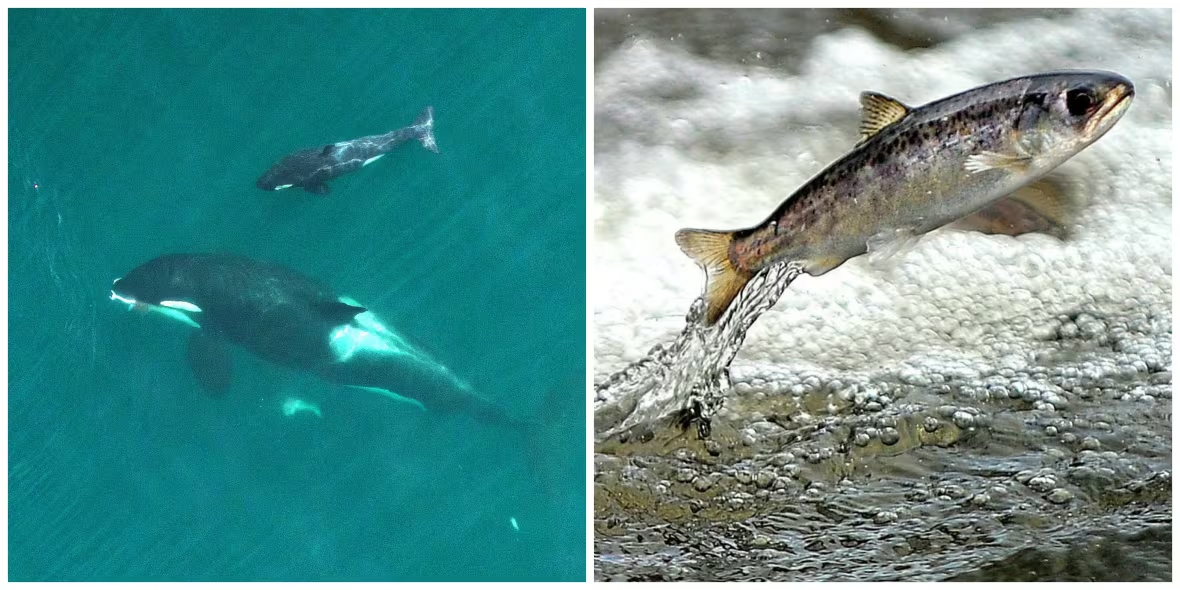The killer whale crisis that a shot won't solve
Why the potential death of one young southern resident killer whale triggered an emergency response

A highly-trained team of scientists takes to the water, tracking the skinny young orca for hours, waiting for the moment to take their shot.
Finally, after a week of fog and choppy water, they're close enough to assess the deteriorating killer whale known as J-50.
Photos show she's losing weight, so much that the blubber on her cranium is sunken in a condition called "peanut head," and her breath smells foul.
The dart lands, containing a dose of long-lasting antibiotic that might help her fight off an infection, if that's the problem.
"Progress!" proclaims the National Oceanic and Atmospheric Administration,(NOAA) announcing the mission on Facebook.
But these scientists and others monitoring J-50's very endangered population of killer whales know gains in their recovery will take far more than a shot.
"As a recovery coordinator for endangered southern residents killer whales, we've been working for over a decade to better understand the threats, the issues," said Lynne Barre with NOAA.
Barre went on to list a series of factors that have pushed the population to a point so critical the potential death of just one young female is being treated with dramatic urgency.
"I think this is an opportunity to learn not only what we can do about the care for J-50, but also help us understand our recovery program for the entire population."
Three-pronged threat
There are only about 75 southern resident killer whales left, down from 96 in 1993. The population hasn't had a successful birth in three years.
Their numbers fell significantly in the 1960s and early 1970s when approximately 47 orcas believed to be from the southern resident population were captured and relocated to aquariums.
While they look, to most humans, like other killer whales on the West Coast, they breed and feed amongst themselves, travelling in tight family groups.
The southern residents make their home in Canadian and U.S. waters, swimming across busy shipping lanes into Vancouver and Seattle, reliant on their favoured food: chinook salmon.

The threats are clear, according to recovery strategies from Canadian and U.S. — a lack of prey, increased vessel noise, and toxic contamination levels.
Supplies of chinook salmon populations have dropped so dramatically, that in May the federal government announced a cut to the allowable catch of chinook salmon by 25 to 35 per cent.
Last year it released 220,000 young salmon into the ocean in the hopes of bolstering the southern resident killer whale population.
Mark Andersen with the Orca Relief Citizens Alliance said that even though killer whales are "world expert sonar technicians," not even they will be able to find fish when noises caused by vessels pollute the waters.
"When the chinook count is low, the presence of motorized craft increases their need for food, and decreases their ability to get food, and they starve," he said.
"And that is it, we're done. That's how they die."

Not giving up
As scientists take on the dramatic rescue effort in the hopes of saving the young whale, J-50 is not the only orca whose plight has made international headlines.
Another southern resident killer whale, J-35 has been carrying the body of her dead calf for a full 17 days as of Friday, in a macabre display of grief that has captured the world's attention.
"You could go back and make a long list of dead whales. And they're each one of them a tragedy," said Andersen.
He hopes that there will eventually be a focus on a long-term solution for the whales, namely a sanctuary area, free of vessels.
"I'm just hoping that people move away from trying to save individual whales in their last days and minutes, and move intelligently into doing the right thing for the whales that are still left."
Though with only 75 whales left, each orca is crucial to the pod's survival — and young females like J-50, even more so.
As scientists taken on this unprecedented rescue effort, they recall another young whale, whose daring rescue ended happily.
Back in 2002 a young whale known as Springer was discovered orphaned and alone in Puget Sound
In what at the time was a controversial move, Springer was treated in captivity then released for reintegration with her pod — and went on to have two calves in the threatened northern resident population.
"We'd love to have another success story and some day see J-50 contribute to population growth for the southern residents," said Barre.
